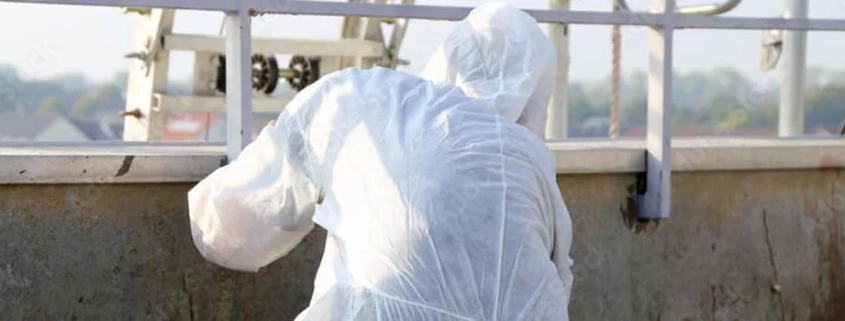Asbestos Respiratory Protection
Asbestos is a poisonous and dangerous dust
Asbestos It is not a gas, it is a tiny and extremely volatile It is a powder composed of filaments. Used in pipes, corrugated sheets, connectors, insulation, coating, flocking, etc. can be found. Any work done on these materials extremely thin hazardous materials has the possibility of spreading.
Once inhaled, fire-resistant fibers are deposited deep into the lungs (pulmonary alveoli). In case of chronic exposure, this dust serious respiratory diseases why could it be . larynx or lung with exposure to asbestos cancer risks The causality between them has been confirmed by IARC (International Agency for Research on Cancer). These diseases occur 10 to 20 years after chronic exposure to the substance.
The European Union now estimates that approximately 80% of occupational cancers are asbestos-related. In 2019, 70,000 people died due to exposure to this toxin.
Asbestos regulations and removal
The decree of 7 March 2013 concerns the selection, maintenance and verification of PPE used during operations that involve a risk of exposure for employees and freelancers. The decree, published in the Journal Officiel dated March 14, 2013, requires employers to provide respirators that protect against asbestos.
In the field of safety, when working with this fiber (asbestos removal works), three categories of dust in workplaces need to be taken into account, which means rating the tools to be applied in order to choose the right product.
- Level 1 : Exposure to asbestos below occupational exposure limit value* (OELV)
- Level 2 : Exposure to asbestos above OELV and below 60 times OELV
- Level 3 : Asbestos exposure 250 times OELV or less
Current VLEP on asbestos exposure as of 1 July 2015 per liter Reduced from 100 fibers to 10 fibers.
The European Commission wants to expand the standard set by France throughout the EU. Many professionals planning to renovate nearly 3 million buildings by 2030 are likely to face health risks. New standards will provide equal protection in all countries
Asbestos respiratory protection equipment
Depending on the amount of particulate matter present in the air (and hence the degree of danger), there are three product categories specializing in asbestos masks as reusable respiratory protection:
- Level 1 (lowest): Gas mask respirators or negative pressure masks. Profile 40 like half mask or Sari or Vision like full mask , With P3 asbestos filter (filter against fine dust, aerosol, viruses or bacteria) equipped
- Level 2 (middle): Proflow 2SC Asbestos One or more motorized air purifying masks with a flow rate of at least 160 l/min, such as with P3 filter Equipped . Lightweight and compact, it offers optimum comfort and is perfectly suitable for long-term asbestos removal operations
- Level 3 (high concentration): From compressed air network or compressed air cylinders (breathing air cart) ( RAS Asbestos etc.) supplied air breathing system (mask with valve). It can be associated with a connection system for a breathing air supply hose and a connection device for an RD40 filter cartridge.
Due to this fiber, a wide range of security systems are available depending on the dust degree and risk analysis of workplaces. For the lowest levels, simple masks ( such as ffp dust masks), motorized air purifying masks ve en yüksek seviyeler için to air supply systems We can find everything.
Numerous accessories, such as high-seal valves or clothing accessories, improve the performance of these respirators.
Asbestos protective clothing
Hazmat suits are PPE suits that offer a waterproof seal to prevent contact between skin and particles . Disposable coveralls help prevent dust from spreading to other clothing. A type 5 disposable garment manufactured according to standard EN 13982-1 is suitable for protection against airborne asbestos dust. Hooded clothing that closes around the neck, ankles and wrists is preferred. Since asbestos removal work often takes a very long time, the material chosen must be breathable and easy to move around in.
Depending on the type of application, you can choose a single garment or a kit that includes all the accessories you need to protect yourself from this powerful fiber. Indeed, the use of waterproof gloves, goggles, appropriate footwear (safety boots or disposable shoe covers) or a special helmet for certain workplaces may be indispensable. This is the perfect complement to a P3 or FFP3 filter mask.
Some professionals also use Alfa bags specifically designed to handle small amounts of asbestos dust, which comply with standards that authorize the removal of asbestos waste.
Which sectors are most affected?
The construction industry is the sector most exposed to asbestos. Professionals working in asbestos removal, whether homes or offices, need this type of equipment.
Waste management workers are the second most exposed sector.
Some industries have secondary contact with asbestos:
- Plumbers, electricians, heating engineers, air conditioners
- Mechanics for light and heavy vehicles
- kitchen installers
All companies that work with asbestos-containing materials have a process to remove all traces of fibers from their clothing. SAS decontamination system should use . Asbestos masks can also be used in building painting jobs. The stock of this PPE is always replenished to meet the needs of the relevant companies, ensuring its safety.
Our range of asbestos respiratory protection equipment
Various depending on dust levels asbestos respiratory protection equipment: from the classic asbestos respirator for level 1 to the powered air purifying respirator for level 2 and asbestos-fed air respirator systems for level 3.



